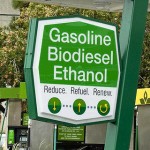EPA Approves E15, Boats Are Exempt
In: Boating
4 Apr 2011 The Environmental Protection Agency waived a limitation on selling fuel that is more than 10 percent ethanol for model-year 2007 and newer cars and light trucks. The waiver applies to fuel that contains as much as 15 percent ethanol, known as E15. The decision excludes marine engines and other non-road engines, such as those on snowmobiles, lawn and garden equipment, and other small gasoline-powered engines. Marine industry groups, including the National Marine Manufacturers Association, the Marine Retailers Association of America and BoatU.S., have vigorously opposed E15.The EPA has spoken, but boats have dodged this bullet for now.
The Environmental Protection Agency waived a limitation on selling fuel that is more than 10 percent ethanol for model-year 2007 and newer cars and light trucks. The waiver applies to fuel that contains as much as 15 percent ethanol, known as E15. The decision excludes marine engines and other non-road engines, such as those on snowmobiles, lawn and garden equipment, and other small gasoline-powered engines. Marine industry groups, including the National Marine Manufacturers Association, the Marine Retailers Association of America and BoatU.S., have vigorously opposed E15.The EPA has spoken, but boats have dodged this bullet for now.
The NMMA is Unhappy with Ruling
Last week the boating industry trade publication Soundings Trade ONLY reported–
The NMMA is concerned that the EPA does not plan to take significant steps to address anticipated problems that involve consumer confusion and the risk of misfueling. The EPA also will not take action to ensure that compatible fuels remain available for the nation’s 13 million registered boat owners or the hundreds of millions of owners of gasoline-powered equipment, the association said after the EPA’s decision.
“We are extremely disappointed that EPA is allowing this fuel to enter the market without the appropriate scientific data or consumer and environmental safeguards,” NMMA president Thom Dammrich said in a statement. “This decision not only adversely impacts marine manufacturers, but creates a significant risk of misfueling for the nation’s 66 million boaters, who will be left ‘holding the bag’ for performance issues and expensive repairs.
“We are astonished that EPA has decided to move forward with a fuel that will increase air pollution and damage hundreds of millions of existing products,” he added.
Cars Have Been Tested
The EPA says it has done vigorous testing to ensure that E15 is safe for cars from model year 2007 and later and the agency reiterated in a press conference that it was holding off a decision on older-model cars. Also, Gina McCarthy, EPA’s assistant administrator for air and radiation, stressed that marine engines and other smaller engines were not included in the waiver. Also, she said, the waiver is not a mandate to force the use of E15.
“EPA is not requiring the use of E15. This decision is not a mandate,” she said. “This decision is about allowing the use of E15.”
“Thorough testing has now shown that E15 does not harm emissions-control equipment in newer cars and light trucks,” EPA administrator Lisa P. Jackson said in a statement. “Wherever sound science and the law support steps to allow more home-grown fuels in America’s vehicles, this administration takes those steps.”
Additional Testing
A decision on the use of E15 in model-year 2001 to 2006 vehicles will be made after the EPA receives the results of additional testing that is expected to be completed in November. However, no waiver will be granted this year for E15 use in model-year 2000 and older cars and light trucks – or in any motorcycles, heavy-duty vehicles or non-road engines – because there are no test data to support such a waiver.
Additionally, steps are being taken to help consumers easily identify the correct fuel for their vehicles and equipment. The EPA is proposing E15 pump-labeling requirements, including a requirement that the fuel industry specify the ethanol content of gasoline sold to retailers.
Back Story
An E15 petition was submitted in March 2009 to EPA by Growth Energy and 54 ethanol manufacturers. In April 2009, EPA sought public comment on the petition and received about 78,000 comments.
The petition was submitted under a Clean Air Act provision that allows the EPA to waive the act’s prohibition against the sale of a significantly altered fuel if the petitioner shows that the new fuel will not cause or contribute to the failure of the engine parts that ensure compliance with the act’s emissions limits.
Source:
www.boattest.com
Welcome to BeaverLakeBoaters!
This site is devoted to all things Beaver Lake Arkansas
Categories





Comments are closed.